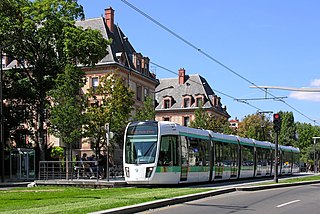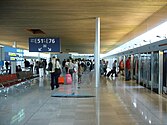
Paris Charles de Gaulle Airport, also known as Roissy Airport, is the primary international airport serving Paris, the capital city of France. The airport opened in 1974 and is located in Roissy-en-France, 23 km (14 mi) northeast of Paris. It is named for World War II leader and French President Charles de Gaulle (1890–1970), whose initials form its IATA airport code.

Orlyval is a light metro shuttle service at Paris's Orly Airport using the Véhicule Automatique Léger driverless, rubber-tyred people mover technology. The line, which opened on 2 October 1991, offers free service between the two airport terminal stations, and premium fare service to Antony station, where passengers can connect to the city's RER B trains. Orlyval is the second line to use the VAL technology after the Lille Metro and the first airport people mover system to use VAL.

Paris Orly Airport is one of two international airports serving Paris, France, the other one being Charles de Gaulle Airport (CDG). It is located partially in Orly and partially in Villeneuve-le-Roi, 13 km (8.1 mi) south of Paris. It serves as a secondary hub for domestic and overseas territories flights of Air France and as the homebase for Transavia France. Flights operate to destinations in Europe, the Middle East, Africa, the Caribbean, South America and North America.

Roissy-en-France, colloquially simply called Roissy, is a commune in the northeastern outer suburbs of Paris, France, in the Val-d'Oise department. It is located 20.7 km (12.9 mi) from the centre of Paris.
An airport rail link is a service providing passenger rail transport between an airport and a nearby city. Direct links operate straight from the airport terminal to the city, while other links require an intermediate use of a people mover or shuttle bus. Advantages for the passenger include faster travel times and easy connections with other public transport. Advantages for the airport include increased patronage and enhanced accessibility for staff. Additionally, authorities have benefitted from less highway congestion, less pollution, and more business opportunities.

Charles de Gaulle–Étoile station is a station on Line 1, Line 2 and Line 6 of the Paris Métro, as well as on Île-de-France's commuter rail RER A. It lies on the border of the 8th, 16th and 17th arrondissements of Paris. Originally called simply Étoile, after its location at Place de l'Étoile, it took on the additional name of President Charles de Gaulle in 1970.

Tremblay-en-France is a commune in the north-eastern suburbs of Paris, France. It is located 19.5 km (12.1 mi) from the centre of Paris.

RER B is one of the five lines in the Réseau Express Régional, a hybrid commuter rail and rapid transit system serving Paris, France and its Île-de-France suburbs. The 80-kilometre (50 mi) RER B line crosses the region from north to south, with all trains serving a group of stations in central Paris, before branching out towards the ends of the line.

The LGV Interconnexion Est is a French high-speed rail line that connects the LGV Nord, LGV Est, LGV Sud-Est and LGV Atlantique through the suburbs of Paris. Opened in 1994, it consists of three branches, which begin at Coubert:

CDG Express is a high-speed railway line currently under construction. It will connect Gare de l'Est in Paris and Charles de Gaulle Airport, aiming to alleviate congestion on the existing RER B line. Originally planned for 2006, the opening was pushed back several times, most recently to early 2027. Upon completion, passengers can expect to travel between the airport and Gare de l'Est in just 20 minutes, covering a distance of 32 kilometres (20 mi).

The Île-de-France tramways is a network of modern tram lines in the Île-de-France region of France. Fourteen lines are currently operational, with extensions and additional lines in both construction and planning stages. Although the system mainly runs in the suburban regions of Paris, lines T3a and T3b run entirely within Paris city limits, while lines T2 and T9 start their routes within Paris' borders. While lines operate independently of each other and are generally unconnected, some connections do exist: between lines T2 and T3a, T3a and T3b, T1 and T5, T1 and T8, T8 and T11 Express, T3a and T9 and T6 and T10. However, the final design of the entire planned tram network is fairly integrated.

Aéroport Charles de Gaulle 2 TGV station is a major passenger railway station in Tremblay-en-France, France. It is directly beneath terminal two of Paris Charles de Gaulle Airport and is operated by the SNCF. The station was opened in November 1994 by President François Mitterrand. It connects the airport to Paris and to various other cities in France, as well as to Belgium.

Groupe ADP, formerly Aéroports de Paris or ADP, is an international airport operator based in Paris (France). Groupe ADP owns and manages Parisian international airports Charles de Gaulle Airport, Orly Airport and Le Bourget Airport, all gathered under the brand Paris Aéroport since 2016.
Rhône-Alpes is a major European transit hub, linking northern France and Europe to the Mediterranean area. Millions travel along its motorways in summertime from Paris to holidays at the sea. The E15 Euroroute runs through the region. There are international airports at Lyon, Grenoble and Saint-Étienne and many other minor airports and airfields.

Aéroport Charles de Gaulle 1 is one of two railway stations at Charles de Gaulle Airport, the primary airport for the Paris region and the largest in France. The station is served by RER B and CDGVAL.
Paris Métro Line 17 is one of four lines of the Grand Paris Express. It is planned to open in phases from 2026 through 2030. Sections will be above ground, including Parc des Expositions station.

Augustin Pascal Pierre Louis Marie de Romanet de Beaune is a French political advisor and business executive, chief executive officer of Groupe ADP since November 2012. He served as the chairman of the Caisse des dépôts et consignations from 2007 to 2012, and held many government positions between 1986 and 2006.

Paris Aéroport, formerly Aéroports de Paris (ADP), is the passenger brand subsidiary of Groupe ADP which operated the airports of Paris and its region, including Paris–Charles de Gaulle, Paris–Orly and Paris–Le Bourget. The company is headquartered at Charles de Gaulle Airport, Tremblay-en-France, Seine-Saint-Denis, in the Paris metropolitan area.

Le Bus Direct was a network of express bus routes operating between Paris and the two major airports in the region and a bus route that connected the two airports. The service has its roots in similar bus routes that started in 1930. The service was terminated on 1 April 2020 as a result of the drop in passengers due to the impact of the COVID-19 pandemic on aviation.

Aéroport d'Orly station is a Paris Métro station serving as the terminus station of Line 14, built as part of the Grand Paris Express project. It is located on the land of the commune Paray-Vieille-Poste and serves Orly Airport, about 13 kilometres (8.1 mi) south of Paris. The station opened with the extension of Line 14 to the south on 24 June 2024, shortly before the start of the 2024 Summer Olympics and 2024 Summer Paralympics.



























